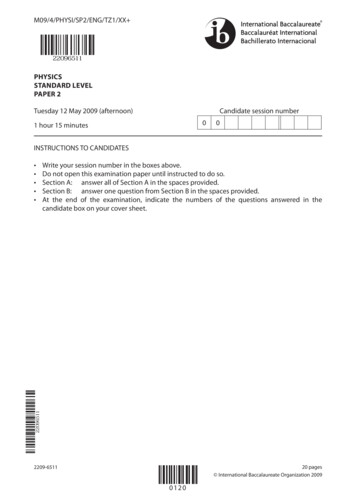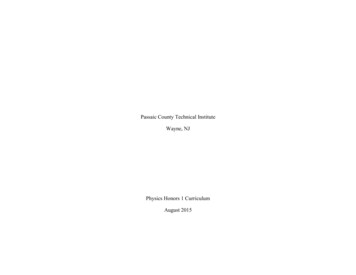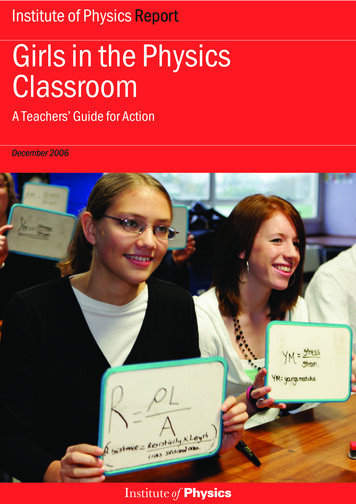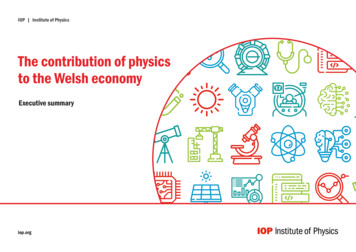
Transcription
M09/4/PHYSI/SP2/ENG/TZ1/XX 22096511PHYSICSSTANDARD LEVELPAPER 2Candidate session numberTuesday 12 May 2009 (afternoon)01 hour 15 minutes0INSTRUCTIONS TO CANDIDATESWrite your session number in the boxes above.Do not open this examination paper until instructed to do so.Section A: answer all of Section A in the spaces provided.Section B: answer one question from Section B in the spaces provided.At the end of the examination, indicate the numbers of the questions answered in thecandidate box on your cover sheet.22096511 20 pages International Baccalaureate Organization 20092209-65110120
–2–M09/4/PHYSI/SP2/ENG/TZ1/XX Section aAnswer all the questions in the spaces provided.a1. This question is about electrical resistance of the metal mercury.The resistance R of a sample of mercury was measured as a function of the temperature T ofthe sample. The sample was cooled and data points were taken at temperature intervals of0.2 K. The uncertainties in R and T are too small to be shown on the graph.654R/Ω 321022.533.544.55T/K5.566.57The hypothesis is that resistance is proportional to absolute temperature for temperatures greaterthan 4.5 K.(a)(i)Suggest whether the data supports the hypothesis.[1].(ii)(b)Draw a line of best fit through the data.[2]State the value of R for which the rate of change of resistance of the sample withtemperature is least.[1].(This question continues on the following page)2209-65110220
–3–M09/4/PHYSI/SP2/ENG/TZ1/XX (Question A1 continued)(c)At a temperature TC the resistance suddenly becomes zero.(i)Use the graph to determine the possible range of the temperature TC .[1].(ii)State, to the correct number of significant figures, the value of TC and itsuncertainty.[2].(iii) Outline how the temperature TC could be measured more precisely.[1].(d)Outline two reasons why you could not use the data to determine an accurate value for Rat room temperature.[2].turn over2209-65110320
–4–M09/4/PHYSI/SP2/ENG/TZ1/XX a2. This question is about impulse.(a)A net force of magnitude F acts on a body. Define the impulse I of the force.[1].(b)A ball of mass 0.0750 kg is travelling horizontally with a speed of 2.20 m s–1. It strikes avertical wall and rebounds horizontally.ball mass0.0750 kg2.20 m s–1 1Due to the collision with the wall, 20 % of the ball’s initial kinetic energy is dissipated.(i)Show that the ball rebounds from the wall with a speed of 1.97 m s–1.[2].(ii)Show that the impulse given to the ball by the wall is 0.313 N s.[2].(This question continues on the following page)2209-65110420
–5–M09/4/PHYSI/SP2/ENG/TZ1/XX (Question A2 continued)(c)The ball strikes the wall at time t 0 and leaves the wall at time t T.The sketch graph shows how the force F that the wall exerts on the ball is assumed to varywith time t.F00TtThe time T is measured electronically to equal 0.0894 s.Use the impulse given in (b)(ii) to estimate the average value of F.[4].turn over2209-65110520
–6–M09/4/PHYSI/SP2/ENG/TZ1/XX a3. This question is about energy transfers.(a)Energy degradation takes place in the energy transformations which occur in thegeneration of electrical power. Explain what is meant in this context by energydegradation.[2].Some of the energy transformations that take place in a coal-fired power station arerepresented by the Sankey diagram below.CoalBoilerDynamo(generator)wCBA(b)(i)State what is represented by the width w.[1].(ii)At the three places marked A, B and C on the diagram, energy is degraded.Identify the process by which the energy is degraded in each of the places.A:.B:.C:.2209-65110620[3]
–7–M09/4/PHYSI/SP2/ENG/TZ1/XX Section bThis section consists of three questions: B1, B2, and B3. Answer one question.b1. This question is in two parts. Part 1 is about greenhouse effect and Part 2 is about motion ofa ball falling in oil.Greenhouse effectPart 1(a)The graph shows part of the absorption spectrum of nitrogen oxide ( N 2 O ) in which theintensity of absorbed radiation A is plotted against frequency f.A / arbitraryunits0(i)123f / 1013 Hz456State the region of the electromagnetic spectrum to which the resonant frequency ofnitrogen oxide belongs.[1].(ii)Using your answer to (a)(i), explain why nitrogen oxide is classified as agreenhouse gas.[2].(This question continues on the following page)turn over2209-65110720
–8–M09/4/PHYSI/SP2/ENG/TZ1/XX (Question B1, part 1 continued)(b)Define emissivity and albedo.[3]Emissivity: . . . . . . . . . . . . . . . . . . . . . . . . . . . . . . . . . . . . . . . . . . . . . . . . . . . . . . . . . . . . .Albedo:.(c)The diagram shows a simple energy balance climate model in which the atmosphere andthe surface of Earth are two bodies each at constant temperature. The surface of the Earthreceives both solar radiation and radiation emitted from the atmosphere. Assume that theEarth’s surface behaves as a black body.344 Wm 2e 0.720α 0.280242 Katmosphereatmospheric radiationsolar radiation288 KEarth’s surfaceThe following data are available for this model.average temperature of the atmosphere of Earthemissivity, e of the atmosphere of Earthaverage albedo, α of the atmosphere of Earthsolar intensity at top of atmosphereaverage temperature of the surface of Earth 242 K 0.720 0.280 344 W m–2 288 K(This question continues on the following page)2209-65110820
–9–M09/4/PHYSI/SP2/ENG/TZ1/XX (Question B1, Part 1 (c) continued)Use the data to show that the(i)power radiated per unit area of the atmosphere is 140 W m–2.[2].(ii)solar power absorbed per unit area at the surface of the Earth is 248 W m–2.[1].(d)It is hypothesized that, if the production of greenhouse gases were to stay at its presentlevel then the temperature of the Earth’s atmosphere would eventually rise by 6.0 K.Calculate the power per unit area that would then be(i)radiated by the atmosphere.[1].(ii)absorbed by the Earth’s surface.[1].(e)Estimate, using your answer to (d)(ii), the increase in temperature of Earth’s surface.[3].(This question continues on the following page)turn over2209-65110920
– 10 –M09/4/PHYSI/SP2/ENG/TZ1/XX (Question B1 continued)Part 2(a)Motion of a ball falling in oilDistinguish between average speed and instantaneous speed.[2].(b)A small steel ball of mass M is dropped from rest into a long vertical tube thatcontains oil.The sketch graph shows how the speed v of the ball varies with time t.v00t2t1tExplain how you would use the graph to find the average speed of the ball betweent 0 and t t1 .[3].(This question continues on the following page)2209-65111020
– 11 –M09/4/PHYSI/SP2/ENG/TZ1/XX (Question B1, part 2 continued)(c)The gradient of the graph at t t1 is k. Deduce an expression in terms of k, M and g,the acceleration of free fall, for the magnitude of the frictional force F acting on theball at t t1 .[3].(d)State and explain the magnitude of the frictional force acting on the ball at t t2 .[3].turn over2209-65111120
– 12 –M09/4/PHYSI/SP2/ENG/TZ1/XX b2. This question is in two parts. Part 1 is about simple harmonic motion and waves and Part 2 isabout the decay of radium-226.Part 1(a)Simple harmonic motion and wavesA particle of mass m that is attached to a light spring is executing simple harmonic motionin a horizontal direction.State the condition relating to the net force acting on the particle that is necessary for it toexecute simple harmonic motion.[2].(b)The graph shows how the kinetic energy EK of the particle in (a) varies with thedisplacement x of the particle from � 0.05 – 0.04 – 0.03 – 0.02 – 0.01(i)00.01 0.02 0.03 0.04 0.05Using the axes above, sketch a graph to show how the potential energy of the particlevaries with the displacement x.[2](This question continues on the following page)2209-65111220
– 13 –M09/4/PHYSI/SP2/ENG/TZ1/XX (Question B2, Part 1 continued)(ii)The mass of the particle is 0.30 kg. Use data from the graph to show that thefrequency f of oscillation of the particle is 2.0 Hz.[4].(c)The particles of a medium M1 through which a transverse wave is travelling, oscillatewith the same frequency and amplitude as that of the particle in (b).(i)Describe, with reference to the propagation of energy through the medium, what ismeant by a transverse wave.[2].(ii)The speed of the wave is 0.80 m s–1. Calculate the wavelength of the wave.[1].(This question continues on the following page)turn over2209-65111320
– 14 –M09/4/PHYSI/SP2/ENG/TZ1/XX (Question B2, part 1 (b) continued)(d)The diagram shows wavefronts of the waves in (c) incident on a boundary XY betweenmedium M1 and another medium M2.wavefrontsYnormaldirection of travel30ºM1M2XThe angle between the normal, and the direction of travel of the wavefronts is 30 .(i)The speed of the wave in M1 is 0.80 m s–1. The speed of the waves in M2 is 1.2 m s–1.Calculate the angle between the direction of travel of the wavefronts in M2 andthe normal.[3].(ii)On the diagram, sketch the wavefronts in M2.[1](This question continues on the following page)2209-65111420
– 15 –M09/4/PHYSI/SP2/ENG/TZ1/XX (Question B2 continued)Part 2(a)Decay of radium-226A nucleus of the isotope radium-226 (Ra) undergoes α-decay with a half life of 1.6 103 yrto form a nucleus of radon (Rn).[2]Define the terms isotope and half-life.Isotope: . . . . . . . . . . . . . . . . . . . . . . . . . . . . . . . . . . . . . . . . . . . . . . . . . . . . . . . . . . . . . . .Half-life: . . . . . . . . . . . . . . . . . . . . . . . . . . . . . . . . . . . . . . . . . . . . . . . . . . . . . . . . . . . . . . .(b)Using the grid below, sketch a graph to show how the activity A of a sample ofradium-226 (Ra) would be expected to vary with time t over a period of about 5.0 103 yr .The activity of the sample at time t 0 is A0.[3]AA0013245t / 10 yr3(This question continues on the following page)turn over2209-65111520
– 16 –M09/4/PHYSI/SP2/ENG/TZ1/XX (Question B2, Part 2 continued)(c)The nuclear reaction equation for the decay of radium-226 (Ra) may be written as22688(i)Ra Rn αState the value of the proton number and neutron number of the isotope ofradon (Rn).[1]Proton number: . . . . . . . . . . . . . . . . . . . . . . . . . . . . . . . . . . . . . . . . . . . . . . . . . . . .Neutron number: . . . . . . . . . . . . . . . . . . . . . . . . . . . . . . . . . . . . . . . . . . . . . . . . . . . .(ii)Outline why the binding energy of Ra is less than that of Rn.[2].(d)The following data are available.mass of Ramass of Rnmass of α 226.0254 u 222.0175 u 4.0026 uShow that the energy released in the decay of a Ra nucleus is 4.94 Me V.2209-65111620[2]
– 17 –M09/4/PHYSI/SP2/ENG/TZ1/XX b3. This question is in two parts. Part 1 is about internal energy, heat and ideal gases and Part 2is about electric fields and electric circuits.Part 1(a)Internal energy, heat and ideal gasesThe internal energy of a piece of copper is increased by heating.(i)Explain what is meant, in this context, by internal energy and heating.[3]Internal energy: . . . . . . . . . . . . . . . . . . . . . . . . . . . . . . . . . . . . . . . . . . . . . . . . . . . .Heating:.(ii)The piece of copper has mass 0.25 kg. The increase in internal energy of the copperis 1.2 103 J and its increase in temperature is 20 K. Estimate the specific heatcapacity of copper.[2].(b)An ideal gas is kept in a cylinder by a piston that is free to move. The gas is heated suchthat its internal energy increases and the pressure remains constant. Use the molecularmodel of ideal gases to explain(i)the increase in internal energy.[1].(ii)how the pressure remains constant.[3].(This question continues on the following page)turn over2209-65111720
– 18 –M09/4/PHYSI/SP2/ENG/TZ1/XX (Question B3 continued)Part 2(a)Electric fields and electric circuitsTwo parallel, charged metal plates A and B are in a vacuum. –––AP ––––BAt a particular instant an electron is at point P.On the diagram, draw(b)(i)the electric field pattern due to the plates.[3](ii)an arrow to represent the direction of the force on the electron at P.[1]The acceleration of the electron at P is 8.8 1014 m s 2 . Determine the magnitude of theelectric field strength at the point P.[3].(c)The electric potential energy of the electron changes by 1.9 10 17 J as it moves from oneplate to the other. Show that the potential difference between the plates is 120 V.[1].(This question continues on the following page)2209-65111820
– 19 –M09/4/PHYSI/SP2/ENG/TZ1/XX (Question B3, part 2 continued)(d)A resistor R and a filament lamp L are connected in series with a battery. The battery hasan emf of 12 V and internal resistance 4.0 . The potential difference across the filamentof the lamp is 3.0 V and the current in the filament is 0.25 A.12 VR(i)LDefine emf and describe the concept of internal resistance.[2]emf:.Internal resistance:.(ii)Calculate the total power supplied by the battery.[1].(iii) Calculate the power dissipated in the external circuit.[2].(This question continues on the following page)turn over2209-65111920
– 20 –M09/4/PHYSI/SP2/ENG/TZ1/XX (Question B3, part 2 (d) continued)(iv) Determine the resistance of the resistor R.2209-65112020[3]
Due to the collision with the wall, 20 % of the ball's initial kinetic energy is dissipated. (i) Show that the ball rebounds from the wall with a speed of 1.97 m s-1. .











